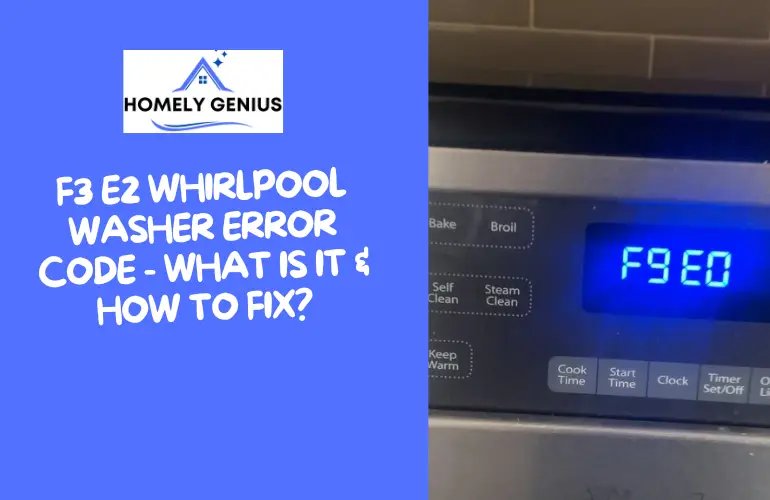
Error codes are like little messages from your appliance. Think of it as your dishwasher’s way of waving a tiny flag, signaling something needs attention. The E2 code, specifically for Whirlpool dishwashers, usually indicates a problem with the water draining out—or a drain pump issue. It might be tempting to brush off these signals, especially when everything else seems to be working just fine. But, here’s the catch: ignoring such signals can lead to bigger problems down the line, not to mention potentially costly repairs.
Understanding Error Code E2
So, what exactly is going on when your Whirlpool dishwasher flashes error code E2? In simple terms, this code is related to the draining system of your dishwasher. Think of the draining system like the plumbing in your home. If there’s a clog or blockage, the water can’t flow as it should, and you end up with a mess. For your dishwasher, this means the water used during a cycle isn’t draining away properly, which could leave you with standing water at the bottom.
This issue could arise from several causes. One common culprit is a clogged or kinked hose. Just as a garden hose that’s kinked won’t let water flow, the same thing can happen with the drain hose in your dishwasher. Another potential cause is a failing drain pump. You might think of the pump as the heart of the dishwashing process: it pushes the used water out, so fresh water can continue to clean your dishes. If the pump is faulty, it’s like having a weak or damaged heart—it just can’t do its job effectively.
So, can you ignore it? Well, that’s a bit like ignoring leaks or strange noises in your car. The longer you wait, the worse the problem can become. Plus, standing water can lead to unpleasant odors and, worse yet, potential mold growth. Tackling this problem promptly is the best way to ensure your dishwasher—and your kitchen—stays in tip-top shape.
What To Do About Error Code E2
Now that we know ignoring the E2 error isn’t ideal, what can you actually do about it? Fortunately, if you’re handy or willing to get a little hands-on, there are steps you can take before calling a professional. First, let’s ensure it’s not a simple fix. Check the drain hose for any visible kinks or clogs. Can you imagine trying to drink from a straw that’s been pinched or filled with debris? Water simply can’t flow through easily, and that’s often the issue.
If the hose looks fine, the next step would be to inspect the drain pump. Finding this might seem intimidating, but it’s often accessible via the bottom panel of your dishwasher. Remove any excess water first—consider it like bailing out water from a small boat to ensure a smoother inspection. Once you’re in, look for any obvious blockages or debris around the pump. Gently clearing these might just solve the issue.
However, if you’re not comfortable doing this yourself, calling a professional is always a smart move. Sometimes, it’s best to let someone with experience take the wheel, especially if diagnosing the issue seems daunting. After all, it’s better to be safe than sorry, right?
Preventive Measures
Prevention is always better than cure, isn’t it? Once you’ve tackled—or fixed—the E2 error, you might be wondering how to prevent it from happening again. Regular maintenance can be your best ally here. Just like you would keep an eye on the health of your car or even the air filter in your home, your dishwasher needs a little love now and then.
Start by cleaning the filter regularly. It’s like brushing your teeth; if done regularly, it prevents build-up. Residue and food particles can clog the system, leading to drainage issues. Additionally, every few months, run an empty cycle with a dishwasher cleaner or a cup of vinegar to help break down any hidden gunk or build-up inside.
Also, be mindful of what goes into your dishwasher. Avoid placing items with excessive food scraps or non-dishwasher safe labels, as they can cause blockages or damage the system. Think of your dishwasher like a delicate machine—it works hard for you, so a bit of care can go a long way.
So, let’s circle back to the big question: should you ignore Whirlpool dishwasher error code E2? In short, no, it’s not wise. Ignoring the error is like turning a blind eye to a warning light on your car dashboard—it might be minor at first, but it could lead to significant problems down the road. Addressing the situation promptly is your best course of action.
By understanding what the E2 code means and taking steps to either fix it yourself or call in the pros, you can keep your dishwasher running smoothly. Adding in some regular maintenance and smart usage habits will help ensure you won’t see that pesky E2 code pop up again anytime soon. Remember, keeping an eye on those little error signals can save you a pile of trouble (and money) later on.